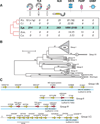Genomic insights into the immune system of the sea urchin
- PMID: 17095692
- PMCID: PMC3707132
- DOI: 10.1126/science.1134301
Genomic insights into the immune system of the sea urchin
Abstract
Comparative analysis of the sea urchin genome has broad implications for the primitive state of deuterostome host defense and the genetic underpinnings of immunity in vertebrates. The sea urchin has an unprecedented complexity of innate immune recognition receptors relative to other animal species yet characterized. These receptor genes include a vast repertoire of 222 Toll-like receptors, a superfamily of more than 200 NACHT domain-leucine-rich repeat proteins (similar to nucleotide-binding and oligomerization domain (NOD) and NALP proteins of vertebrates), and a large family of scavenger receptor cysteine-rich proteins. More typical numbers of genes encode other immune recognition factors. Homologs of important immune and hematopoietic regulators, many of which have previously been identified only from chordates, as well as genes that are critical in adaptive immunity of jawed vertebrates, also are present. The findings serve to underscore the dynamic utilization of receptors and the complexity of immune recognition that may be basal for deuterostomes and predicts features of the ancestral bilaterian form.
Figures


References
Publication types
MeSH terms
Substances
Grants and funding
LinkOut - more resources
Full Text Sources
Other Literature Sources
Medical
Miscellaneous

